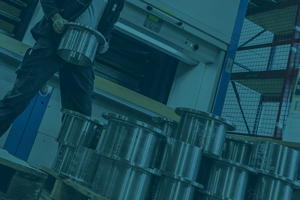Liners are used to protect the rotating propeller shafts of ships against wear; preventing the wear of liners has always been a struggle. It’s a challenge to protect the liners’ running surface in a way that the lifetime will be lengthened by many years. This blog will tell you more about the two most-often chosen liners for the protection of rotating shafts.
In this blog we differentiate between two kinds of liners:
- Chrome steel
- Tungsten (HML)
Please note that cast iron and ceramic liners are still used, but we don’t supply them any more. Ceramic liners are an outdated method of liner protection; technical developments have presented us with better alternatives. Given the fact that ceramic is very brittle and has a higher (2–5%) porosity value, we prefer tungsten (HML) liners.
The liner of the forward seal is always shaft-centred. The liner of the aft seal is mostly hub-centred, but can also be shaft-centred.
Overview
Check the summary below for an overview of the different kinds of liners. In short, the greater the surface hardness, the more expensive the liner.
Chrome steel liner
- Lifetime: Medium
- Extra coating?: No
- Machinable?: Yes
- Price: Medium
- Total Costs of Ownership: Medium
Tungsten HML liner
- Lifetime: High
- Extra coating? Yes
- Machinable? No
- Price: High
- Total Costs of Ownership: Low
Chrome steel liners
Chrome steel liners consist of steel with added chrome to increase the resistance to corrosion. They are made of duplex stainless steel and used for aft and forward seal boxes. The aft seal prevents water ingress to the stern tube and oil leakage to the outside environment. The forward seal prevents oil leakage from the stern tube to the engine room. For chrome steel liners it’s possible to machine the surface. The machining allowances can be found in the liner information sheet (ask for access), but they mostly have an allowable diameter reduction of 1 to 2 millimetres.
Tungsten HML liners
Tungsten HML liners are made of stainless steel and executed with a HML (Hard Metal Layer) coating. The coating is a tungsten carbide enhanced layer that is applied by High Velocity Oxygen Fuel (HVOF) spraying production technology. The thermal spray improves the resistance against wear and corrosion. This HVOF layer is harder than the rest of the material and of a different composition. A liner completely made out of hard metal is very difficult to manufacture on a lathe, so instead the hard metal is added to the liner as an extra protective layer.
The threaded HVOF liner with HML does not need remachining, because the lip seals won’t create grooves in the liner and therefore pulling the shaft or removing the propeller hub for this sole purpose is history. The HML can be applied on all our non-split chrome steel liners.
The lifetime of a liner may be extended up to 20 years (in ideal conditions) depending on the specific operating conditions of the Supreme® seal. Customer experiences show that after 5–10 years of operation, the HML coated liners show virtually no wear. This means that the Total Costs of Ownership for HML liners will go down. Please note that a tungsten HML liner can’t be machined.
No need to pull the shaft
Pulling the shaft or removing the propeller for a leaking seal is a costly operation. With a split type liner you avoid doing this. Split liners can be hub-centred or shaft-centred. Split liners are applicable to all our Supreme seals for propeller shafts. Of course, the fully-split Supreme seal execution also has – like all Supreme seals – divisible housing parts and lip seals. All our liners are machined in our own production facility at our headquarters in Alblasserdam.
Extra protection against corrosion
Most vessels use anodes to protect the submerged part of the ship. If you want improved liner protection against corrosion, anode blocks are a must-have. The anode blocks will sacrifice themselves and protect the liner from corrosion.
Contact
Contact us if you wish to receive more information or have questions about our liners.


